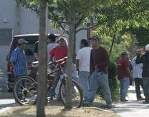 [Video below.] Over the back windows of a weathered cottage-like building on First Street hangs a row of flags, each representing a Hispanic region. So far, there are three: Mexico, Honduras and Puerto Rico.
[Video below.] Over the back windows of a weathered cottage-like building on First Street hangs a row of flags, each representing a Hispanic region. So far, there are three: Mexico, Honduras and Puerto Rico.
Ken Seda hopes to add more. As he sees it, every new one hung means another group of immigrants has gained a voice in Central Jersey.
“We’re forming a civic group for each country,” said Seda, a 51-year-old Puerto Rican who runs a financial consulting firm in the building’s front while serving day laborers coffee and doughnuts in the back. “As they start to meet, their flag will go up.”
Still to come: Costa Rica, Peru and Columbia. El Salvadorians have organized in the region but have yet to get a flag.
Not everyone agrees with Seda’s approach. Rita Dentino, who leads the immigrant advocacy group Casa Freehold, politely declined to participate, saying: “It’s not that we don’t want to recognize all the countries, but we don’t want to separate them, either.”
But the strategy to create union-like coalitions based on nationality does represent a broader effort these days by many advocates and public officials to empower low-income immigrant workers and integrate them into their larger communities.
On Friday, some 40 mostly undocumented immigrant day laborers crowded into Seda’s tiny back room to hear Mayor Steven Langert talk about options. Langert acknowledged he might have gotten it wrong in June when he went only as far as designating a muster zone in a municipal lot for the laborers to flag down employers. He then pledged to help the hundreds of workers toward assimilation in town as long they do their part, namely staying in the zone and off Clifton Avenue.
For the laborers, it could soon mean identification cards to secure a lease or a cell phone account, computer and language classes, trade skills training, and open doors at the community center on Fourth Street during cold morning hours.
“The culture of America is not to hang out on the streets all day,” Langert told the workers Friday through a translator.
Avoiding the sensitive debate over illegal immigration, the mayor added: “The fact is you are here and you want to work, and we want to help you if we can. And in return we want you to help us.”
Some of the workers requested more signs posted to direct contractors to the muster zone, and a shelter for when the weather turns bad.
“When it rains, we run to the businesses to take cover,” said Memo Angeles, 38, a laborer in Lakewood for three years. “If we have a roof, we wouldn’t have to go there.”
Langert said it was possible to bring to the municipal lot the shelter once erected at a previous – and wholly unsuccessful – muster zone in the industrial park. He held fast, however, to the notion that the laborers get nothing until they prove willing to stay put.
The workers have historically not been well-received by business owners and many residents, who find their curbside loitering bad for the town’s reputation. These critics also see any offers of services, and the muster zone particularly, as encouraging an illegal immigrant work force.
“But burying my head in the sand is not going to make it go away,” Langert said later by phone.
Issuing immigrants ID cards and providing space for classes is nothing new. Princeton, Asbury Park and Queens have all issued them. Casa Freehold is modeling cards for Freehold laborers after Trenton, Dentino said. Her group also has held computer and language courses, as well as forums on legal rights. Freehold has had its own muster zone on Throckmorton Street since 2003.
What’s perhaps more remarkable, then, is the theme of immigrant integration and empowerment that has resonated throughout Central Jersey.
In Lakewood, workers plan to hold routine “Cleaning Days,” during which they will sweep the public sidewalks and paint over graffiti. Similar cleaning campaigns are happening in Freehold, where laborers wear bright yellow shirts donated by local merchants. The goal: to be visible as conscientious neighbors.
Meanwhile, Seda’s civic groups are meeting to discuss labor, education, health care and immigration issues within their own circles.
When Gregg Cavallero was brought off the streets in Brick by a Queens church group, he was an undocumented worker from Mexico busing tables at various restaurants and addicted to drugs. Now he has started his own church in Lakewood, speaks fluent English and is Seda’s right-hand man with managing the muster zone. Cavallero expects to see his residency papers come through this year, more than a decade after coming across the border.
On Friday, he recalled the life of an undocumented worker.
“You feel lonely sometimes – like nobody cares,” the now married 30-year-old said. “I see the need here for these people. And I came to help.”
Click below for a video of Langert meeting with immigrants in Lakewood:
[media id=1033 width=400 height=300]
{APP/Matzav.com}












How about sending the illegals there back to the countries where they belong?
#1 Come on, how about TRUE emes: what if these were our brethren?